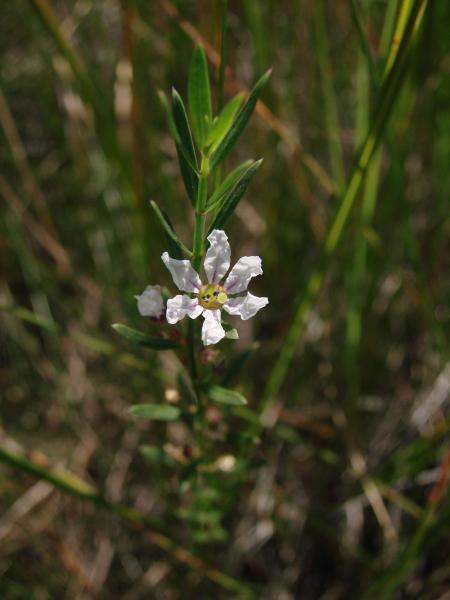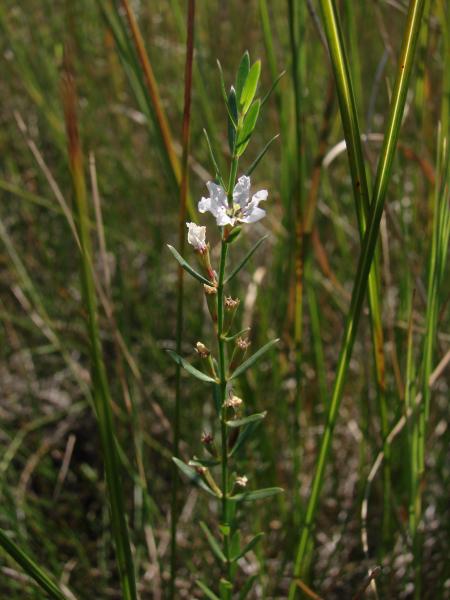Saltmarsh Loosestrife
Lythrum lineare L.
- Class
- Dicotyledoneae (Dicots)
- Family
- Lythraceae (Loosestrife Family)
- State Protection
- Endangered
Listed as Endangered by New York State: in imminent danger of extirpation in New York. For animals, taking, importation, transportation, or possession is prohibited, except under license or permit. For plants, removal or damage without the consent of the landowner is prohibited.
- Federal Protection
- Not Listed
- State Conservation Status Rank
- S1
Critically Imperiled in New York - Especially vulnerable to disappearing from New York due to extreme rarity or other factors; typically 5 or fewer populations or locations in New York, very few individuals, very restricted range, very few remaining acres (or miles of stream), and/or very steep declines.
- Global Conservation Status Rank
- G5
Secure globally - Common in the world; widespread and abundant (but may be rare in some parts of its range).
Summary
Did you know?
The genus name is derived from the word lytron, a name used by the ancient Greek botanist Dioscorides for the well known aquatic weed purple loosestrife. The species name refers to its linear leaves (Fernald 1950).
State Ranking Justification
There are two existing populations, one with hundreds of plants while the other is of unknown size and quality. There are no other historical records known from the state.
Short-term Trends
The one large existing population's short-term trend seems stable although there is phragmites invading the area.
Long-term Trends
The long-term trend is uncertain but may be positive. The large population was first documented in 1933, while the new population was found in 2004.
Conservation and Management
Threats
Phragmites is invading the salt marshes where this species occurs. It threatens to eliminate both populations.
Conservation Strategies and Management Practices
Phragmites needs to be eliminated from the saltmarshes where this species occurs.
Research Needs
Research is needed to discover a technique that will allow augmentation of populations.
Habitat
Habitat
Saltmarsh loosestrife occurs in a high-quality saltmarsh in salt flats between the Spartina patens high marsh and the zone of Baccharis shrubs (New York Natural Heritage Program 2012). Brackish marshes (Gleason and Cronquist 1991). Brackish to saline marshes (Fernald 1950).
Associated Ecological Communities
- High salt marsh
(guide)
A coastal marsh community that occurs in sheltered areas of the seacoast, in a zone extending from mean high tide up to the limit of spring tides. It is periodically flooded by spring tides and flood tides. High salt marshes typically consist of a mosaic of patches that are mostly dominated by a single graminoid species.
Associated Species
- Agalinis maritima
- Baccharis halimifolia (groundsel-tree)
- Fimbristylis castanea (marsh fimbry)
- Limonium carolinianum (sea-lavender)
- Phragmites australis (old world reed grass, old world phragmites)
- Spartina patens (salt-meadow cord grass)
- Suaeda
- Symphyotrichum tenuifolium
Range
New York State Distribution
There are two existing occurrences, and one additional historical occurrence from eastern Suffolk County on Long Island.
Global Distribution
Lythrum lineare grows on the coastal plains of the Atlantic and Gulf Coast from Connecticut to Louisiana and Texas. It is rare from New Jersey northward. There are a few inland populations in Alabama, Mississippi, Louisiana, and Texas.
Identification Comments
General Description
Saltmarsh loosestrife is a small perennial wildflower with erect, hairless stems 4 -15 dm tall and branched above. The leaves are only 4 mm wide and narrowed to a sessile base. They become smaller and more narrow above. The flowers arise in the axils of the leaves on short pedicels. The thin, crinkly petals are pale purple to white. The styles are of different lengths in different flowers (heterostylic) (Gleason and Cronquist 1991).
Best Life Stage for Proper Identification
It is best to identify this plant when it is in flower.
Similar Species
Annual loosestrife, Lythrum hyssopifolia, is an exotic loosestrife which can occur in saltmarshes and has been found on Staten Island. It is an annual and the leaves are mostly alternate, not opposite. The styles of the flowers are all the same length. The flower color can be very similar to that of Lythrum lineare (Gleason and Cronquist 1991).
Best Time to See
The best time to identify Lythrum lineare is when it is in flower during August and September.
- Vegetative
- Flowering
- Fruiting
The time of year you would expect to find Saltmarsh Loosestrife vegetative, flowering, and fruiting in New York.
Saltmarsh Loosestrife Images
Taxonomy
Saltmarsh Loosestrife
Lythrum lineare L.
- Kingdom Plantae
- Phylum Anthophyta
- Class Dicotyledoneae
(Dicots)
- Order Myrtales
- Family Lythraceae (Loosestrife Family)
- Order Myrtales
- Class Dicotyledoneae
(Dicots)
- Phylum Anthophyta
Additional Resources
Best Identification Reference
Gleason, Henry A. and A. Cronquist. 1991. Manual of Vascular Plants of Northeastern United States and Adjacent Canada. The New York Botanical Garden, Bronx, New York. 910 pp.
Other References
Crow, Garrett E. and C. Barre Hellquist. 2000. Aquatic and Wetland Plants of Northeastern North America: A revised and enlarged edition of Norman C. Fassett's a Manual of Aquatic Plants. Volume One: Pteridophytes, Gymnosperms, and Angiosperms: Dicotyledons. The University of Wisconsin Press. Madison, Wisconsin. 536 Pages.
Fernald, M. L. 1950. Gray's manual of botany. 8th edition. Corrected printing (1970). D. Van Nostrand Company, New York. 1632 pp.
Holmgren, Noel. 1998. The Illustrated Companion to Gleason and Cronquist's Manual. Illustrations of the Vascular Plants of Northeastern United States and Adjacent Canada. The New York Botanical Garden, Bronx, New York.
New York Natural Heritage Program. 2010. Biotics database. New York Natural Heritage Program. New York State Department of Environmental Conservation. Albany, NY.
New York Natural Heritage Program. 2024. New York Natural Heritage Program Databases. Albany, NY.
Weldy, T. and D. Werier. 2010. New York flora atlas. [S.M. Landry, K.N. Campbell, and L.D. Mabe (original application development), Florida Center for Community Design and Research http://www.fccdr.usf.edu/. University of South Florida http://www.usf.edu/]. New York Flora Association http://newyork.plantatlas.usf.edu/, Albany, New York
Links
About This Guide
This guide was authored by: Stephen M. Young
Information for this guide was last updated on: September 6, 2012
Please cite this page as:
New York Natural Heritage Program. 2024.
Online Conservation Guide for
Lythrum lineare.
Available from: https://guides.nynhp.org/saltmarsh-loosestrife/.
Accessed July 27, 2024.

